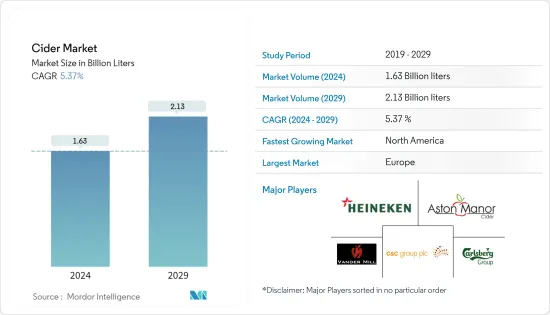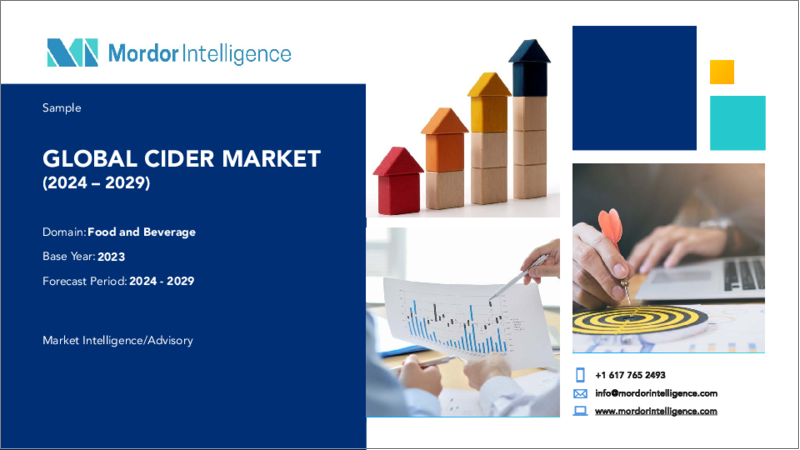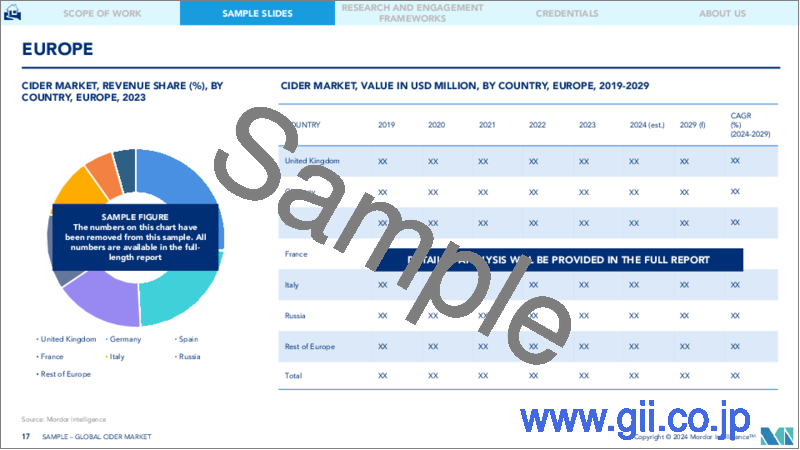|
|
市場調査レポート
商品コード
1433935
シードル:市場シェア分析、産業動向と統計、成長予測(2024年~2029年)Cider - Market Share Analysis, Industry Trends & Statistics, Growth Forecasts (2024 - 2029) |
||||||
カスタマイズ可能
適宜更新あり
|
|||||||
| シードル:市場シェア分析、産業動向と統計、成長予測(2024年~2029年) |
|
出版日: 2024年02月15日
発行: Mordor Intelligence
ページ情報: 英文 120 Pages
納期: 2~3営業日
|
全表示
- 概要
- 目次
シードル市場規模は2024年に16億3,000万リットルと推定され、2029年までに21億3,000万リットルに達すると予測されており、予測期間(2024年から2029年)中に5.37%のCAGRで成長します。

主なハイライト
- アルコール飲料の需要の増加、消費者の収入の増加、さまざまな飲料に関する情報の普及に重点を置いた団体の数などの要因が、シードル市場の成長を促進すると予想されます。
- 市場の企業は、風味と洗練さの点で新製品の革新を考え出すことが観察されています。たとえば、2019年3月、ディアジオはアイルランドのシードル市場への足がかりを築こうとするグループの試みとして、ロックショア・アップル・シードルを発売しました。
- しかし、世界の多くの地域、特にアジアではシードルに対する認知度は依然として低いため、生産者にとって大きなチャンスとなっており、その多くが国際的な存在感を拡大し、市場全体で製品の認知度を高めることに取り組んでいます。
シードル市場の動向
グルテンフリーのアルコール飲料の需要が急増
グルテンを含まず、夏にはビールよりも甘く爽やかなシードルを好むアルコール消費者が増えています。 ACE CiderやCrispin Cider Co.などのさまざまなシードルメーカーは、シードルはグルテンを含まないリンゴから直接原料を使用しているため、ほとんどのシードルは当然グルテンフリーであると主張しています。セリアック病に関連するグルテン不耐症の増加と、高品質の食品や飲料の摂取に関する知識の増加により、グルテンフリー製品の需要が高まっています。さらに、グルテンフリー飲料はコレステロール値を改善し、消化器官の健康を促進すると考えられています。したがって、消費者は、健康上の利点と予防接種を提供する、天然の栄養ベースの飲み物に傾いています。健康特性は発展途上国にとって特に重要であり、消費者は製品のより多くの健康上の利点に対して割増価格を支払うことをいとわないです。したがって、セリアック病の増加とグルテンフリー製品の需要の増加に伴い、ビールに代わる適切なグルテンフリー代替品としてシードルの需要が増加すると予想されます。
地理的範囲の拡大に関する戦略的投資
欧州、特に英国はシードルの顕著な市場であり、シードルは最も人気のあるアルコール飲料の1つとして消費されています。ただし、大きな拡大範囲を持つ市場には、普及率が低いためアジア太平洋、新興市場プレーヤーによる北米が含まれます。米国では、シードルはビールの代替品として位置づけられることが多いです。しかし、シードル市場はそれほど発展していませんが、米国では平均アルコール消費率が高いため、発展する大きなチャンスがあります。また、グルテンフリー飲料であるため、国内で着実に成長すると予想されています。グルテンを避ける消費者からの需要の高まりに対応。
シードル業界の概要
世界のシードル市場は、多数の地域および世界的プレーヤーの存在により細分化されています。 Heinken NV、Carlsberg Breweries A/S、C&C Group Plcなどの主要企業は、製品ポートフォリオを拡大し、市場シェアを拡大するための重要な戦略として製品イノベーションを利用しています。たとえば、2017年にハインケンNVは、3種類の在来種リンゴから作られた職人技のブレンドシードルをストロングボウ製品に追加しました。この製品革新は、同社の製品ポートフォリオの拡大に役立ちました。主要企業はまた、統合を達成し、サービスを最適化するための重要な戦略の1つとして、拡大や合併・買収にも着手しています。さらに、これらのプレーヤーは地元のプレーヤーと合併して、地元市場での優位性を獲得します。
その他の特典
- エクセル形式の市場予測(ME)シート
- 3か月のアナリストサポート
目次
第1章 イントロダクション
- 調査の前提条件と市場定義
- 調査範囲
第2章 調査手法
第3章 エグゼクティブサマリー
- 市場概要
第4章 市場力学
- 市場促進要因
- 市場抑制要因
- ポーターのファイブフォース分析
- 新規参入業者の脅威
- 買い手・消費者の交渉力
- 供給企業の交渉力
- 代替品の脅威
- 競争企業間の敵対関係の強さ
第5章 市場セグメンテーション
- 製品タイプ
- フレーバーシードル
- プレーンシードル
- 流通チャネル
- 専門店
- スーパーマーケット/ハイパーマーケット
- オンライン小売店
- その他のチャネル
- 地域
- 北米
- 米国
- カナダ
- メキシコ
- その他北米地域
- 欧州
- 英国
- ドイツ
- フランス
- ロシア
- イタリア
- スペイン
- その他欧州
- アジア太平洋
- インド
- 中国
- 日本
- オーストラリア
- その他アジア太平洋地域
- 南米
- ブラジル
- アルゼンチン
- その他南米
- 中東・アフリカ
- 南アフリカ
- その他中東とアフリカ
- 北米
第6章 競合情勢
- 最も採用されている戦略
- 市場シェア分析
- 企業プロファイル
- Heineken N.V.
- Agrial(Aston Manor Brewery)
- Carlsberg Breweries A/S
- Asahi Premium, Ltd
- Seattle Cider Company
- Vander Mill Ciders
- Woodchuck Cidery
- Molson Coors Brewing Company(Smith & Forge)
- Angry Orchard Cider Company, LLC.
- C&C Group plc
第7章 市場機会と今後の動向
The Cider Market size is estimated at 1.63 Billion liters in 2024, and is expected to reach 2.13 Billion liters by 2029, growing at a CAGR of 5.37% during the forecast period (2024-2029).

Key Highlights
- Factors, such as increasing demand for alcoholic beverages, rising income of consumers, and the number of associations focused on disseminating information about different beverages, are expected to drive the cider market's growth.
- Companies in the market are observed to come up with new product innovations in terms of flavor and sophistication. For instance, in March 2019, Diageo launched Rockshore Apple Cider, in the group's attempt to gain a foothold in the Irish cider market.
- However, awareness about cider remains negligible across much of the world, especially in Asia, thereby presenting a major opportunity for producers, many of which are working to widen their international presence and raise product awareness across markets.
Cider Market Trends
Surge in Demand for Gluten-Free Alcoholic Beverages
A growing number of alcohol consumers prefer cider over a beer as it is gluten-free, and often sweeter and more refreshing than beer during summer. Various cider manufacturers such as ACE Cider and Crispin Cider Co. claim that most of their cider are naturally gluten-free because cider comes directly from apples which contain zero gluten. Rising instances of gluten-intolerance, associated with celiac disease and increase in knowledge of consuming quality food and beverage is propelling the demand for gluten-free products. Additionally, gluten-free beverages are believed to improve cholesterol levels and promote digestive health. Thus, consumers are inclined towards natural and nutrient-based drinks, which provide health benefits and immunization. Health attributes are particularly important to develop countries, in which consumers are willing to pay a premium price for more health benefits in a product. Thus, with rising instances of celiac disease and increasing demand for gluten-free products, the demand for cider is expected to rise as a suitable gluten-free alternative to beer.
Strategic Investments in Terms of Expanding Geographical Reach
Europe, particularly the United Kingdom, is a prominent market for cider, with cider being one of the most popular alcoholic beverages consumed. However, some of the markets having a large scope of expansion include Asia-Pacific, due to low penetration and North America, due to emerging market players. In the United States, cider is often positioned as an alternative to beer. However, the cider market is not as developed and has a great opportunity to develop due to the high average alcohol consumption rates in the U.S. Moreover, it is gluten-free beverage, and thus, it is expected to grow steadily in the country, due to the growing demand from gluten avoiding consumers.
Cider Industry Overview
The Global cider market is fragmented, due to the presence of numerous regional and global players. Key players, such as Heinken N.V., Carlsberg Breweries A/S, C&C Group Plc are using product innovation as a key strategy to expand their product portfolio and increase their market shares. For instance, in 2017, Heinken N.V. added artisanal blends cider made from three varieties of heirloom cider apples to its Strongbow range of products. This product innovation helped the company to expand its product portfolio. The key players are also embarking on expansions and mergers and acquisitions as one of their key strategies to achieve consolidation and optimize their offerings. Moreover, these players merge with local players to gain dominance in the local markets.
Additional Benefits:
- The market estimate (ME) sheet in Excel format
- 3 months of analyst support
TABLE OF CONTENTS
1 INTRODUCTION
- 1.1 Study Assumptions & Market Definition
- 1.2 Scope of the Study
2 RESEARCH METHODOLOGY
3 EXECUTIVE SUMMARY
- 3.1 Market Overview
4 MARKET DYNAMICS
- 4.1 Market Drivers
- 4.2 Market Restraints
- 4.3 Porter's Five Force Analysis
- 4.3.1 Threat of New Entrants
- 4.3.2 Bargaining Power of Buyers/Consumers
- 4.3.3 Bargaining Power of Suppliers
- 4.3.4 Threat of Substitute Products
- 4.3.5 Intensity of Competitive Rivalry
5 MARKET SEGMENTATION
- 5.1 Product Type
- 5.1.1 Flavored Cider
- 5.1.2 Plain Cider
- 5.2 Distribution Channel
- 5.2.1 Speciality Stores
- 5.2.2 Supermarket/Hypermarkets
- 5.2.3 Online Retail Stores
- 5.2.4 Other Channels
- 5.3 Geography
- 5.3.1 North America
- 5.3.1.1 United States
- 5.3.1.2 Canada
- 5.3.1.3 Mexico
- 5.3.1.4 Rest of North America
- 5.3.2 Europe
- 5.3.2.1 United Kingdom
- 5.3.2.2 Germany
- 5.3.2.3 France
- 5.3.2.4 Russia
- 5.3.2.5 Italy
- 5.3.2.6 Spain
- 5.3.2.7 Rest of Europe
- 5.3.3 Asia Pacific
- 5.3.3.1 India
- 5.3.3.2 China
- 5.3.3.3 Japan
- 5.3.3.4 Australia
- 5.3.3.5 Rest of Asia-Pacific
- 5.3.4 South America
- 5.3.4.1 Brazil
- 5.3.4.2 Argentina
- 5.3.4.3 Rest of South America
- 5.3.5 Middle East & Africa
- 5.3.5.1 South Africa
- 5.3.5.2 Rest of Middle East & Africa
- 5.3.1 North America
6 COMPETITIVE LANDSCAPE
- 6.1 Most Adopted Strategies
- 6.2 Market Share Analysis
- 6.3 Company Profiles
- 6.3.1 Heineken N.V.
- 6.3.2 Agrial (Aston Manor Brewery)
- 6.3.3 Carlsberg Breweries A/S
- 6.3.4 Asahi Premium, Ltd
- 6.3.5 Seattle Cider Company
- 6.3.6 Vander Mill Ciders
- 6.3.7 Woodchuck Cidery
- 6.3.8 Molson Coors Brewing Company (Smith & Forge)
- 6.3.9 Angry Orchard Cider Company, LLC.
- 6.3.10 C&C Group plc






